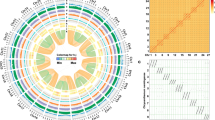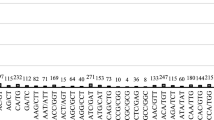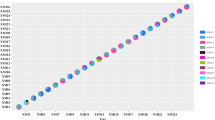Abstract
A study was undertaken to determine whether inheritance in the bivalent-forming, hexaploid Chrysanthemum morifolium is diploid-like (selective chromosome pairing) or hexasomic (random chromosome pairing). Self-compatible genotypes, nulliplex for the dominant allele I (Carotenoid Inhibitor), were crossed with I-possessing cvs. Pink Marble and Pollyanne. Segregation ratios for the progenies of the Pollyanne (putative triplex) crosses indicated hexasomic inheritance. Simplex selections from the Pink Marble progenies were selfed to obtain duplex genotypes with alleles of I on pairing homologues if diploid-like inheritance was occurring. However, subsequent crosses with the nulliplex cv. Canary gave progenies which segregated 4:1 (carotenoid−:carotenoid+), providing strong evidence for a hexasomic mode of inheritance.
Similar content being viewed by others
Article PDF
References
Dawson, C D R. 1941. Tetrasomic inheritance in Lotus corniculatus L. J Genet, 42, 49–72.
Dowrick, G J. 1952. The chromosomes of Chrysanthemum, I: The species. Heredity, 6, 365–375.
Dowrick, G J. 1953. The chromosomes of Chrysanthemum, II: Garden varieties. Heredity, 7, 59–72.
Drewlow, L W, Ascher, P D, and Widmer, R E. 1973. Genetic studies of self incompatibility in the garden chrysanthemum, Chrysanthemum morifolium Ramat. Theor Appl Genet, 43, 1–5.
Endo, N. 1969a. The chromosome survey on the cultivated chrysanthemums, Chrysanthemum morifolium Ram. I. On the chromosome numbers of cultivated chrysanthemums (Part 1). J Jpn Soc Hortic Set, 38, 267–274.
Endo, N. 1969b. The chromosome survey on the cultivated chrysanthemums, Chrysanthemum morifolium Ram. II. On the chromosome numbers of cultivated chrysanthemums (Part 2). J Jpn Soc Hortic Sci, 38, 343–349.
Jordan, C, and Reimann-Philipp, R. 1983. Untersuchungen iiber Typ und Grad der Polyploidie von Chrysanthemum morifolium Ramat. durch Erbanalysen von zwei Bluten-farbmerkmalen. Z Pflanzenzuecht, 91, 111–122.
Langton, F A. 1976. Techniques of chrysanthemum breeding. The Chrysanthemum Year Book 1976, Gosling, S. (ed.) National Chrysanthemum Society, pp. 42–53.
Langton, F A. 1980. Chimerical structure and carotenoid inheritance in Chrysanthemum morifolium (Ramat.). Euphytica, 29, 807–812.
Nazeer, M A, and Khoshoo, T N. 1983. Variation in the chromosome complement of Chrysanthemum morifolium complex. Nucleus (Calcutta), 26, 22–29.
Nazeer, M A, and Khoshoo, T N. 1985. Meiotic variations in Chrysanthemum morifolium complex. Nucleus (Calcutta), 28, 35–41.
Nordenskiôld, H. 1953. A genetical study in the mode of segregation in hexaploid Phleum pratense. Hereditas, 39, 469–488.
Ronald, W G, and Ascher, P D. 1975. Self compatibility in garden Chrysanthemum: Occurrence, inheritance and breeding potential. Theor Appl Genet, 46, 45–54.
Watanabe, K. 1977. The control of diploid-like meiosis in polyploid taxa of Chrysanthemum (Compositae). Jpn J Genet, 52, 125–131.
Watanabe, K. 1983. Studies on the control of diploid-like meiosis in polyploid taxa of Chrysanthemum. Theor Appl Genet, 66, 9–14.
Author information
Authors and Affiliations
Rights and permissions
About this article
Cite this article
Langton, F. Inheritance in Chrysanthemum morifolium Ramat.. Heredity 62, 419–423 (1989). https://doi.org/10.1038/hdy.1989.57
Received:
Issue date:
DOI: https://doi.org/10.1038/hdy.1989.57
This article is cited by
-
Genome-wide association study overcomes the genome complexity in autohexaploid chrysanthemum and tags SNP markers onto the flower color genes
Scientific Reports (2019)
-
Conclusive evidence for hexasomic inheritance in chrysanthemum based on analysis of a 183 k SNP array
BMC Genomics (2017)
-
Microsatellite polymorphism among Chrysanthemum sp. polyploids: the influence of whole genome duplication
Scientific Reports (2015)
-
SRAP-based mapping and QTL detection for inflorescence-related traits in chrysanthemum (Dendranthema morifolium)
Molecular Breeding (2011)
-
Rapid detection of genetic variability in chrysanthemum (Dendranthema grandiflora Tzvelev) using random primers
Heredity (1993)



